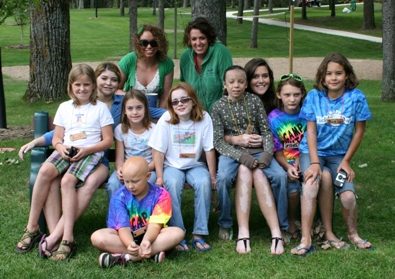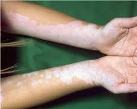For the best viewing experience, please click Winter Newsletter to open in browser.
 |
||||||||||||||||||||||||
|
Dear Members and Friends of VSI, In this winter issue, in order to give our staff and volunteers a little extra time to relax and spend time with their families, we are featuring a previously-published 2010 newsletter article that was very popular with our readers. For those of you who may have missed this article, "How To Tell If My Treatment Is Working," we hope you find it informative and helpful. For those of you who have read it, we hope you find new insights.
Sincerely, Jackie Gardner
PS. After many requests, PayPal is here! We hope you will also take the opportunity this holiday season to make a donation to VSI. You can use our new “easy button” PayPal link located around the website as well as here in the newsletter. This does not require any VSI registration, account or login! A PayPal account is also not required; all credit cards are accepted.
Treatment results will vary by person. Some people will begin to see results within 3 to 6 months. Others may not see results for 8 months. The rule of thumb is that you will need to allow at least 3 to 6 months before you begin to see results from ANY treatment. Additionally, you should expect to treat for up to two years or longer in order to see good results. If you try a treatment for 3 months and then quit because you saw no results, chances are you needed more time. It is vital to use any treatment consistently and correctly. If you don’t use a treatment as directed by your physician, it can take much longer to work or it may not work at all. For best results, how do I use light as a treatment? When using light such as sunlight or Narrowband UVB (NB-UVB), the goal is to expose the depigmented area to the light source long enough so that you see a nice pink color within 12-18 hours after the light exposure. This is the same reaction you see anytime you expose your skin to sunlight. You never want to burn (turning red rather than pink) pigmented OR depigmented skin, as it is unhealthy for your skin and this type of trauma can actually cause vitiligo to spread or worsen. How long are NB-UVB treatment times? Beginning NB-UVB treatment times would be around 15-20 seconds. If you do not see any pinking within 12-18 hours, you can use NB-UVB again the next day and increase the time by 5-10 seconds and so on. Once you reach a level where you get pink but do not burn, and the color goes away within 24-36 hours, you can maintain that time as long as you are still achieving the pink. Some people will remain at the same level for weeks or months. Once you no longer see pink, you probably need to increase your time again. Always take care when increasing time that you do not increase too much. It is better to take an extra day to achieve the desired results than it is to risk burning. How long should I expose my skin if I am using sunlight to treat? That depends on several factors such as the time of year and your latitude (proximity to the sun). The closer to the equator you are, the stronger the rays. Sunlight generally takes a little longer exposure than NB-UVB because sunlight contains the full light spectrum rather than only the therapeutic rays of NB-UVB. As with NB-UVB, you need to begin conservatively in order not to risk burning. Depending upon the time of year and the climate, a general rule of thumb would be to begin with around 15 minutes of sun, increasing the time minimally as needed to maintain the therapeutic dose (getting pink). What will the repigmentation look like? Some areas will begin regaining normal skin color by closing in from the outside edges so that the depigmented area slowly gets smaller and smaller until it is fully repigmented. Some areas will instead begin to get freckles inside the depigmented area. These freckles begin as very small dots and grow in size until they are islands that fuse together, filling in the depigmented area. Some areas will be a combination of both. Some people experience a bit of hyper-pigmentation (darker than normal skin color) when they begin repigmenting. The new freckles themselves or the outside edges of the depigmented area may initially show this hyperpigmentation. This ordinarily subsides before too long and the color will even out to the normal skin tone. How long will it take to see results from a topical (ointment or cream) treatment? Topical treatments alone usually take longer to produce results than a topical combined with light. With a topical treatment alone, results might not be evident for 8 months or longer. Topicals combined with light generally produce results even faster than with light alone. Once again, it is very important for topical treatments to be used as your doctor prescribes with regard to frequency of treatment, method of application and how long the topical should be left on prior to washing.
What's on your Mind? Q. My doctor prescribed Protopic and NB-UVB for me. Should I have the Protopic on my skin while using the light? A. While having Protopic on your skin during a light treatment may or may not reduce the therapeutic effect, it will not help. Some topicals need to be on the skin when using light because they are "light-sensitizing." This is the case for example, with PUVA treatment. PUVA stands for Psoralen + UVA (light). A psoralen is a light-sensitizing drug and needs to be either taken orally, or applied to the skin (topically), just prior to exposure to the light treatment or exposure in order to make the skin more sensitive and responsive to the light. Although Protopic does make the skin more sensitive in some individuals, it is not classified as a light-sensitizing drug. Vitiligo is an autoimmune disease where the body mistakenly identifies its own melanocytes (pigment-making cells) as a foreign substance and attacks and kills them. When (and where) Protopic is applied to the skin, as an immunomodulating drug, its function is to block (turn off) the immune response, allowing the melanocytes to again flourish. Protopic's ability to block the immune response is a somewhat cumulative process. It's not immediate like a psoralen, and it does not need light in order to work. If applied daily, after a period of several weeks or even months, the melanocytes once again begin to repopulate the previously depigmented area. By adding light to this or any therapy, you are increasing melanocyte stimulation. NB-UVB stimulates melanocytes whether or not Protopic is being used. Protopic suppresses the immune response where applied whether or not light is used. One is not dependent on the other. A. Protopic does seem to make the skin of some people more sensitive to heat and cold and others seem to experience what you describe, a greater sensitivity to UV light. Though it is not a light-sensitizing drug per se, it contains ingredients to increase the medication's ability to penetrate the skin. Some doctors feel it is these ingredients used to enhance absorption that increase this type of sensitivity in some patients. It might be a good idea to drop your time back a bit when you first combine these two treatments until you get a feel for what type of response you might have.
Highlights of recently-published medical Mixed Vitiligo Is Recommended as a New Vitiligo Classification New findings lead researchers to recommend that mixed vitiligo (MV), the combination of segmental vitiligo (SV) and nonsegmental vitiligo (NSV), should be included as a third classification of vitiligo. Until now, the separation of patients with vitiligo into only two clinical subtypes or classifications, SV and NSV, has not been challenged. However, doctors at the Department of Dermatology and National Centre for Rare Skin Disorders in Bordeaux, France, report finding the combination of segmental and nonsegmental vitiligo in 19 patients, indicating there is a need for a third classification, as this may be essential to the understanding of the pathogenesis of vitiligo. Most of the 19 patients had long-standing disease, with vitiligo first appearing before the age of 18. In most, SV had preceded NSV. In all of the patients except for two, NSV responded well to NB UVB phototherapy, whereas SV responded poorly (SV typically responds poorly to conventional NB UVB therapy as compared to NSV). In the two remaining patients, response to treatment was good in both SV and NSV. The researchers speculated that the differences in response to therapy in SV may be linked to some underlying cutaneous defect. The researchers recommended further work to understand the link between SV and NSV in MV. In particular, the inflammatory stage that is commonly detected in progressive NSV is not sufficiently documented in SV to suggest a common pathological mechanism. Research into this area they felt was of prime importance.
Vitiligo Starting in Childhood May Differ from Late-Onset Vitiligo Researchers at the University of Athens Department of Dermatology found distinct differences between those who developed vitiligo as children as opposed to those who developed vitiligo as adults. These differences included the type of vitiligo they had, and susceptibility to thyroid disease and allergic diseases. They examined 394 patients over a five-year period. Their study revealed several differences between childhood- and later-onset vitiligo. Childhood-onset vitiligo: (1) involved different sites at initial presentation; (2) included more cases of segmental type, (3) had a lower connection to stressful events at initial presentation, (4) demonstrated a slower rate of progression, (5) was characterized by a higher prevalence of allergic diseases and a lower prevalence of thyroid disease, and (6) was characterized by different risk factors for the presence of thyroid disease (longer duration of disease and positive family history of thyroid disease), compared with later-onset vitiligo (female sex).
Seeking Participants for Paid Micrografting Clinical Trial
Major Expansion of Vitiligo Genetics Project
One of the first steps in coping is finding a doctor knowledgeable about vitiligo and current treatments and capable of providing emotional support. If depression is a problem, you should let your doctor know, as mental health professionals can help stabilize the emotions. It is very important to educate yourself on vitiligo and treatments for several reasons.
Consider this: Before you had vitiligo, if you bought a new outfit to wear to a special event, when you put it on you felt like a million bucks! If someone gave a second look as you passed by, you were probably pleased that your new outfit was noticed.
 In 1993, the American Academy of Dermatology (Academy) started Camp Discovery with a single camp location serving about 50 kids at Camp Knutson in Crosslake, Minnesota. Little did they know how much Camp would grow over the next 19 years. Camp Horizon began in 1995; Teen Camp followed in 1998 and last year we introduced Camp Reflection in Washington State. This year the Academy is proud to offer six camping sessions for young people with chronic skin conditions who are between the ages of 8 and 16. Under the expert care of dermatologists and nurses, Camp Discovery gives campers the opportunity to spend a week with other young people with skin conditions, while participating in everything from swimming and fishing to horseback riding to lots of camp games and just plain fun! There is no fee to attend this very special camp. Full scholarships, including transportation, are provided by the Academy through generous donations from its members, outside organizations and individuals. All campers must be referred by their dermatologists. 2012 Dates:
Referral forms will be available in January and the application deadline is April 15, 2012. For more information about attending or volunteering, please visit the Camp website at www.campdiscovery.org, or contact Janine Mueller at 847-240-1737 or by email: [email protected].
Earn funding for VSI 3 Ways when you Shop! Please keep VSI in mind when you do any of your online shopping
|
|||||||||||||||||||||||
| Copyright © 2011 Vitiligo Support International Inc. All rights reserved. Reproduction or republication strictly prohibited without prior written permission A Vitiligo Support International, Inc. financial statement is available upon written request from the Virginia Office of Consumer Affairs. Mail requests to: Virginia Department of Agriculture and Consumer Services, Office of Consumer Affairs, P.O. Box 1163, Richmond, Virginia 23218. |
||||||||||||||||||||||||




 How can I tell if I am getting enough light? You should always begin conservatively so as not to burn, then increase your time slowly until you gain the desired effect. Always remember, pink is good - red is not! Within 24-36 hours, the pink should turn back to the normal depigmented color; then it is OK to treat again. Most doctors recommend treating with light around 3 days a week.
How can I tell if I am getting enough light? You should always begin conservatively so as not to burn, then increase your time slowly until you gain the desired effect. Always remember, pink is good - red is not! Within 24-36 hours, the pink should turn back to the normal depigmented color; then it is OK to treat again. Most doctors recommend treating with light around 3 days a week.
 How can I tell if light treatment is working? One of the best ways to tell if light (or any treatment) is working is to begin with good photos of the areas you are treating. That is the most accurate way to follow your progress. With light (as well as any other treatment) you will need to be very consistent with your treatment in order to expect positive results. If you are using light at a therapeutic dose (getting pink) at least three days a week, every week, within 3 to 6 months you should begin to see some signs of repigmentation.
How can I tell if light treatment is working? One of the best ways to tell if light (or any treatment) is working is to begin with good photos of the areas you are treating. That is the most accurate way to follow your progress. With light (as well as any other treatment) you will need to be very consistent with your treatment in order to expect positive results. If you are using light at a therapeutic dose (getting pink) at least three days a week, every week, within 3 to 6 months you should begin to see some signs of repigmentation.



 Vitiligo may cause changes in appearance that can affect people's emotional and psychological well-being and may cause them to alter their lifestyle, becoming less active in social activities. Many experience emotional stress as vitiligo develops on visible areas of the body. Adolescents, already concerned about appearance, can be devastated. It is not uncommon for those with vitiligo to feel embarrassed, ashamed, depressed, or worried about how others will react.
Vitiligo may cause changes in appearance that can affect people's emotional and psychological well-being and may cause them to alter their lifestyle, becoming less active in social activities. Many experience emotional stress as vitiligo develops on visible areas of the body. Adolescents, already concerned about appearance, can be devastated. It is not uncommon for those with vitiligo to feel embarrassed, ashamed, depressed, or worried about how others will react. Another important step in coping with vitiligo is establishing support with family and friends and talking with others who have vitiligo. It may make life less complicated to explain to those close to you that vitiligo is a genetic skin condition that doesn’t hurt and is not contagious. The alternative is to try to keep it a secret, which usually serves to further bottle up emotions.
Another important step in coping with vitiligo is establishing support with family and friends and talking with others who have vitiligo. It may make life less complicated to explain to those close to you that vitiligo is a genetic skin condition that doesn’t hurt and is not contagious. The alternative is to try to keep it a secret, which usually serves to further bottle up emotions.  If you notice someone glancing over their shoulder or taking a second look, most mean no ill will. It’s just human nature to look at something that catches your eye. Nine times out of ten, if you flash a smile and extend a friendly “Hi!,” it will be returned. Those who might be rude are acting out of their own insecurity. For some reason, it makes them feel better about themselves to put others down. Don’t give anyone else the power over your confidence and emotions. If you’re feeling down, reach out to others. Doing something nice for someone else can often do even more for you than for the other person!
If you notice someone glancing over their shoulder or taking a second look, most mean no ill will. It’s just human nature to look at something that catches your eye. Nine times out of ten, if you flash a smile and extend a friendly “Hi!,” it will be returned. Those who might be rude are acting out of their own insecurity. For some reason, it makes them feel better about themselves to put others down. Don’t give anyone else the power over your confidence and emotions. If you’re feeling down, reach out to others. Doing something nice for someone else can often do even more for you than for the other person!